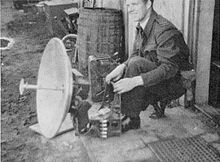FuG 240 Berlin

The FuG 240 "Berlin" was a radar device of the German Air Force in World War II. It was made by Telefunken and fielded in April 1945. It was the most advanced German airborne intercept radar unit of that conflict and already incorporated all the main features of current devices. Only 25 units could be produced before the war ended.
Instead of a large directional antenna, as used by previous German radar sets up until the Lichtenstein radar, the FuG 240 had a small parabolic antenna that could be installed in the nose of an aircraft behind a plywood fairing. This improved aerodynamics, leading to a 50 km/h increase in air speed.
The FuG 240 was only ever used in the night fighter Ju 88 G-6. The Germans were only able to develop the new, smaller radar device after they had captured British units from downed aircraft which they called "Rotterdam-Gerät" (probably H2S radars). These used cavity magnetrons which had previously been unknown in Germany. Thanks to this very short wavelength technology, much smaller devices with more power and a greater range could be designed. While "Lichtenstein" had used 60 cm waves, "Berlin" generated 9 cm waves. This made it possible to reduce antenna size by a factor of 7.
Image gallery
-
Ju88 G-6 with FuG-240 behind the plywood nose
-
A year after the end of the war, this American copy appeared
Technical specifications
- Power: 15 kW
- Search angle: +/− 55°
- Antenna diameter: 70 cm
- Frequency range: 3,250–3,330 MHz
- Range: 500–9,000m


